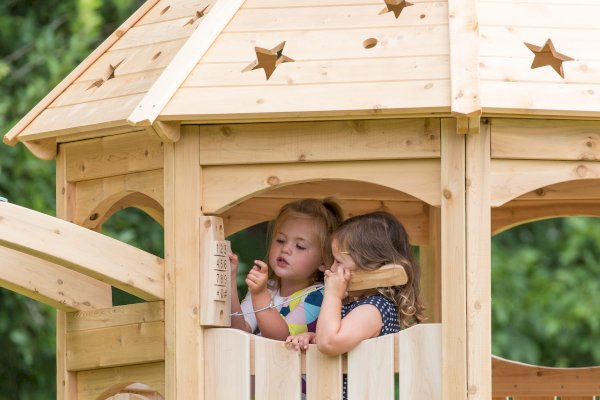Planning for your new playset: the best playset materials
Expert Advice | 6 years ago

It’s March, and spring—traditionally the season for playset shopping—is right around the corner. If you are thinking about a new playset for your family, you might be a little overwhelmed by all the options and decisions you need to make including what is the best playset material. Plastic? Metal? Wood? Vinyl-coated? Each material has a unique set of pros and cons such that there is no universal "right" choice, so your decision should be based on what makes the most sense for your family and your budget.
Metal playsets are less common now than when they were at their peak in the 50s to 70s, but there are still metal swing set manufacturers. Metal residential swing sets are generally inexpensive and require little maintenance, but they are not built to support a lot of weight, so if you want to be able to play on the swing set with your kids, this may not be your best option.
Plastic playsets are usually small and targeted to toddlers, so they won’t be suitable for older children, but they are inexpensive and relatively maintenance free.
Pressure treated wood playsets are usually made of a soft wood like pine that is then chemically treated. They are long-lasting and relatively inexpensive, but they have a significant environmental impact due to the chemicals they contain, and they will require regular maintenance to reduce the risk of splinters.
Vinyl-coated pressure treated wood swing sets eliminate some of the disadvantages of traditional pressure treated wood as the vinyl coating means no splinters and no direct contact with the chemicals used to treat the wood. They tend to be more expensive, however, and the vinyl content and chemical treatment have a significant impact on the environment.
Wood is now one of the most popular materials for residential playsets. Wood varies a great deal in terms of cost and quality, however, depending on what kind you choose, but it will usually be more expensive than metal or plastic playsets.
Playsets made of Chinese “cedar” first began being shipped to the U.S. on a wide scale in the early 2000s. The chief advantage of Chinese cedar playsets is that they are less expensive than playsets made from domestic wood species while still offering a wide variety of sizes and accessories. They are often stained to look like redwood. They are widely available and can be found at big box stores. The disadvantage of these playsets is that they are usually made from a smaller dimension wood, so they have lower weight limits than domestic cedars or redwood. They also require regular maintenance including sanding and staining to reduce splinters, and their longevity is not known since they haven’t been on the market for very long.
Northern White Cedar (full disclosure: this is the wood CedarWorks uses for all of its outdoor play equipment) is a domestic wood that has been popular for outdoor uses for hundreds of years. It is naturally attractive, rot-resistant and splinter-free, so it does not require staining or sanding for longevity. Northern White Cedar is uniquely suited to outdoor playsets and furniture. Its main disadvantage is that it is more expensive than imported wood playsets.
Redwood is native to northwestern areas of the U.S. It has been used in premium playset manufacture for decades. It is strong and naturally long-lasting, but it does require regular maintenance to prevent splinters. It is also one of the more expensive playset materials.
The playset material you choose will depend on your budget, whether you want high weight limits on your playset to accommodate the whole family, how much maintenance you are willing to do, and how long you want your set to last.
For more information on everything you need to know before buying a playset, check out Swing Sets 101 and our Swing Set Buyer’s Guide.
#children#family
#fun
#outdoor
#parenting
#swing-set